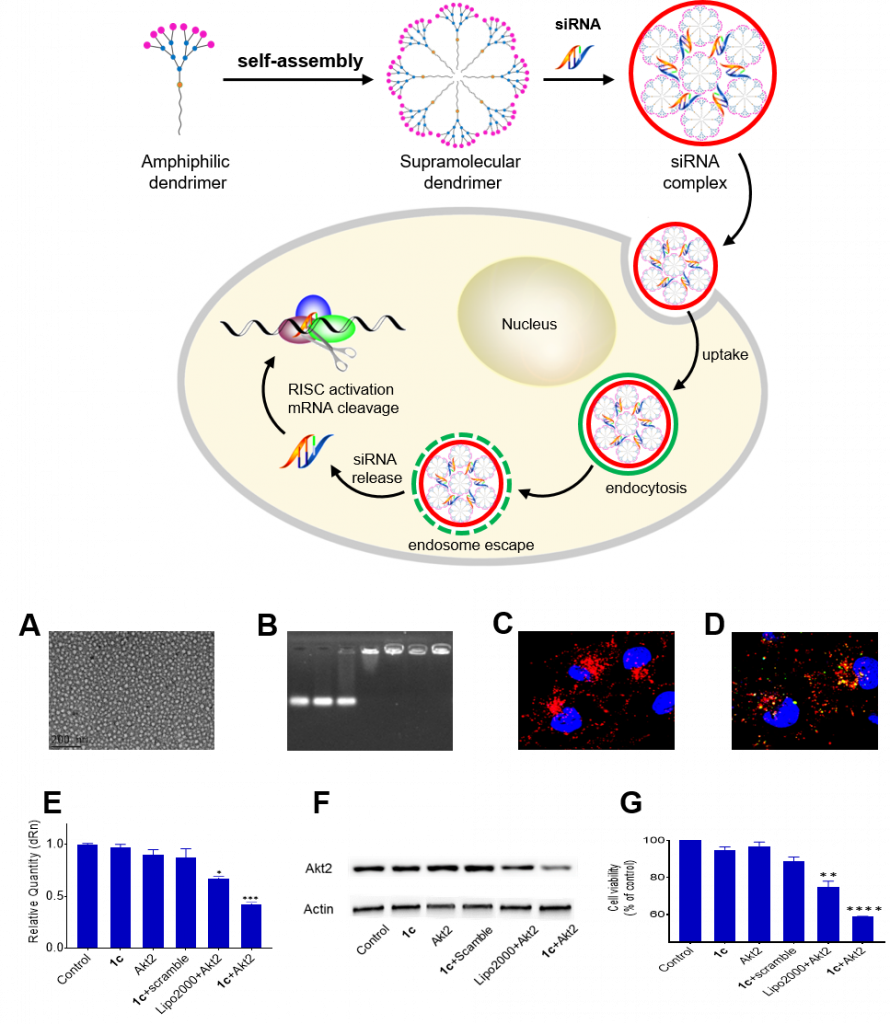An ionizable supramolecular dendrimer nanosystem for effective siRNA delivery with a favorable safety profile
An ionizable supramolecular dendrimer nanosystem for effective siRNA
delivery with a favorable safety profile
Dinesh Dhumal, Wenjun Lan, Ling Ding, Yifan Jiang, Zhenbin Lyu, Erik Laurini, Domenico Marson, Aura Tintaru, Nelson Dusetti, Suzanne Giorgio, Juan Lucio Iovanna, Sabrina Pricl, and Ling Peng
Nano Research, https://doi.org/10.1007/s12274-020-3216-8
http://www.thenanoresearch.com/upload/justPDF/3216.pdf
Gene therapy using small interfering RNA (siRNA) is emerging as a novel therapeutic approach to treat various diseases. However, safe and efficient siRNA delivery still constitutes the major obstacle for clinical implementation of siRNA therapeutics. Here we report an ionizable supramolecular dendrimer vector, formed via self-assembly of a small amphiphilic dendrimer, as an effective siRNA delivery system with a favorable safety profile. By virtue of the ionizable tertiary amine terminals, the supramolecular dendrimer has a low positively charged surface potential and no notable cytotoxicity at physiological pH. Nonetheless, this ionizable feature imparted sufficient surface charge to the supramolecular dendrimer to enable formation of a stable complex with siRNA via electrostatic interactions. The resulting siRNA/dendrimer delivery system had a surface charge for favorable cellular uptake and endosomal release of the siRNA. When tested in different cancer cell lines and patient-derived cancer organoids, this dendrimer-mediated siRNA delivery system effectively silenced the oncogenes Myc and Akt2 with a potent antiproliferative effect, outperforming the gold standard vector, Lipofectamine 2000. Therefore, this ionizable supramolecular dendrimer represents a promising vector for siRNA delivery. The concept of supramolecular dendrimer nanovectors via self-assembly is new, yet easy to implement in practice, offering a new perspective for supramolecular chemistry in biomedical applications.
This is a collaborative study among Centre Interdisciplinaire de Nanoscience de Marseille (CINaM), Centre de Recherche en Cancerologie de Marseille (CRCM), Institut de Chimie Radicalaire (ICR) at Aix-Marseille University in France, and University of Trieste, Trieste, Italy.

Figure: Schematic illustration of the supramolecular dendrimer formed via self-assembly of an ionizable amphiphilic dendrimer for siRNA delivery. (A) A representative transmission electron microscopy (TEM) image of the supramolecular dendrimer nanomicelles formed by ionizable tertiary amine terminated dendrimer, (B) complex formation between siRNA and the ionizable supramolecular dendrimer, (C) Cellular uptake of the (Cy3)-labeled siRNA/dendrimer complexes in human pancreatic cancer (Panc-1) cells revealed using confocal microscopic imaging, (D) siRNA release upon endosomal escape, siRNA-mediated gene silencing of the oncogenes Akt2 (E) at mRNA level assessed using qRT-PCR and at (F) protein level using western blotting, and (G) the resulting antiproliferative effect on Panc-1 cells determined using MTT assay.
Contact:
Dr. Ling Peng,
Email: ling.peng@univ-amu.fr
Aix-Marseille Université, CNRS, Centre Interdisciplinaire de Nanoscience de Marseille (CINaM) UMR 7325, Equipe Labellisé par La Ligue, Marseille, France
